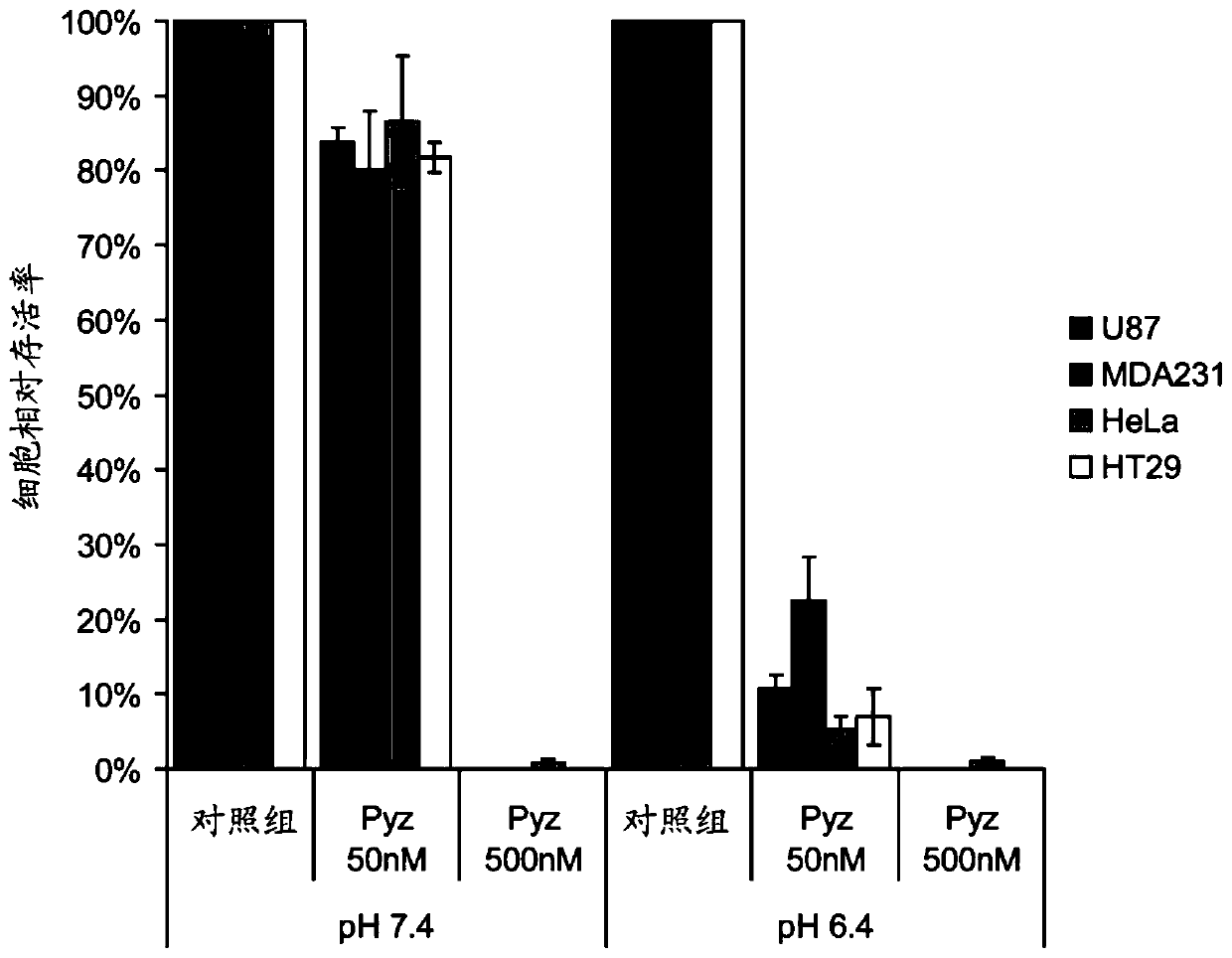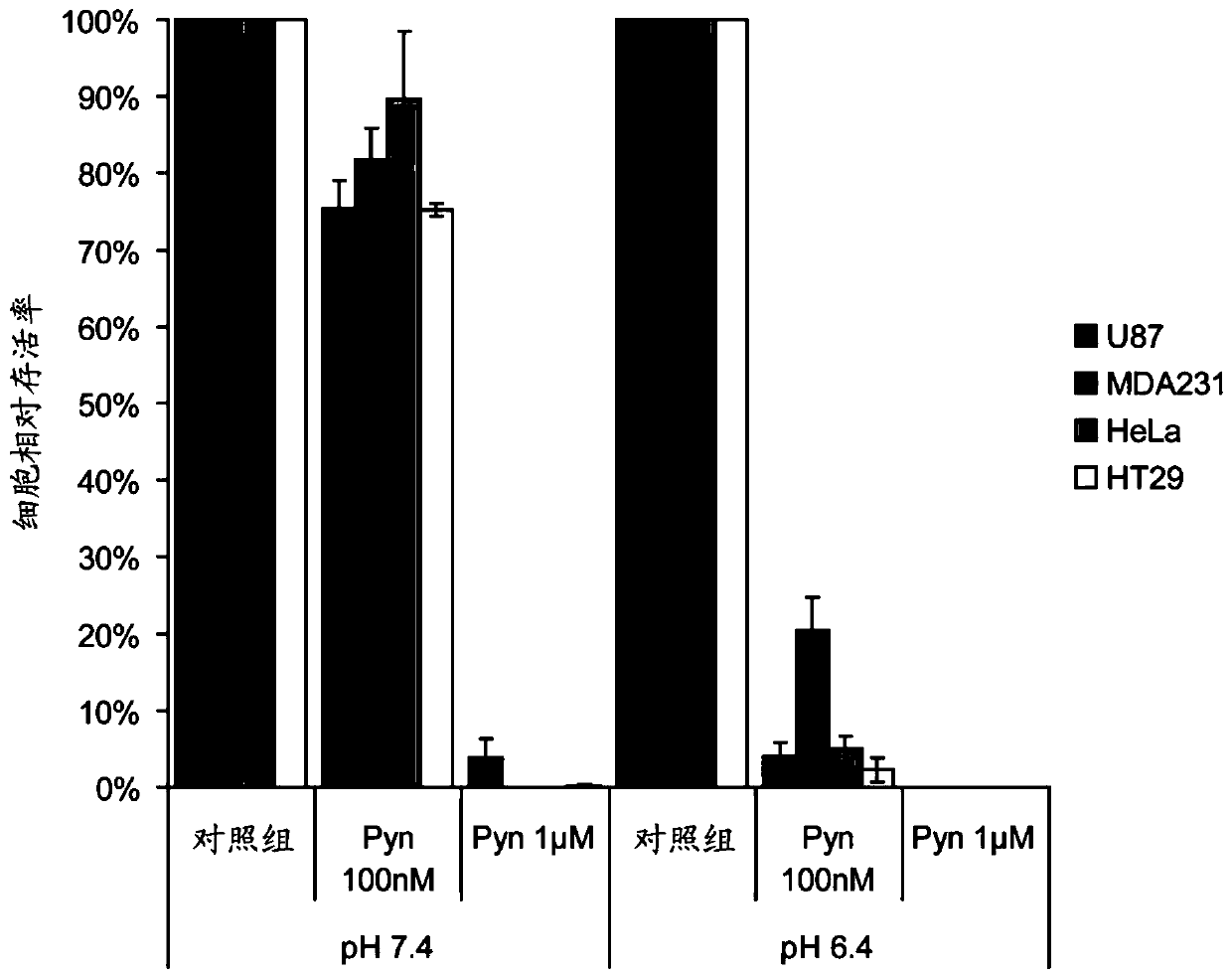Compositions for treatment of malignant tumors and precancerous conditions, methods of use thereof and methods for manufacturing medicaments
A composition and compound technology, applied in antineoplastic drugs, chemical instruments and methods, compounds of Group 5/15 elements of the periodic table, etc., can solve the problems of not providing methods or compositions for curing or preventing cancer, and achieve The effect of inhibiting proliferation
- Summary
- Abstract
- Description
- Claims
- Application Information
AI Technical Summary
Problems solved by technology
Method used
Image
Examples
Embodiment 1
[0096] Cell lines and reagents, colon cancer HT29 cell line, breast cancer MDA-MB-231, glioma U87 and skin cancer A2058 cells were obtained from the American Type Culture Collection (ATCC). These cancer cells were trypsinized and resuspended in cryopreservation medium containing 90% medium consisting of Dalbecco's Modified Eagle's Media (DMEM) and 10% fetal bovine serum (FBS).
[0097] Human cervical carcinoma HeLa was supplemented with 10% DMSO and stored in liquid nitrogen until use. Prior to the experiment, cells were recovered from liquid nitrogen and incubated in DMEM containing 10% FBS in an atmosphere of 5% CO 2 grow down. When cells reached approximately 80% confluency, cells were trypsinized and subdivided at a 1:4 ratio. To grow cells without exposure to test compounds, DMEM supplemented with 3.7 g / L sodium bicarbonate and pH adjusted to 7.3, supplemented with 10% FBS, and cells maintained at 37 °C in 5% CO 2 in the incubator. To study the pH-dependent and dose-d...
Embodiment 2
[0099] Effects of zinc pyrithione (Pyz) treatment at pH 7.4 and pH 6.4 on cancer cell viability.
[0100] Malignant tumors establish a characteristic acidic extracellular pH of 6.0-6.9, whereas normal tissues have a neutral pH of 7.3-7.4 (Parks et al., 2013). This demonstrates the exposure of zinc pyrithione to four different types of human cancer cells from cervical cancer (HeLa cells), brain tumor (U87 cells), colon cancer (HT29 cells) and breast cancer (MDA-MB-231 cells) lead to a significant decrease in cell viability. Treatment with zinc pyrithione significantly reduced cell viability when treated in acidic media at pH 7.4 compared to when treated at pH 7.4. The chemical structure of zinc pyrithione is as figure 1 shown.
[0101] Cancer cells were seeded onto 96-well culture dishes at 2,000 / well in an atmosphere of 5% CO 2 Incubate overnight at 37°C in the presence of DMEM supplemented with 10% FBS. To study the pH-dependent anticancer effects of pyrithione and other...
Embodiment 3
[0104] Effect of pyrithione sodium (Pyn) treatment at pH 7.4 and pH 6.4 on cancer cell viability.
[0105] Zinc pyrithione or other heavy metals chemically conjugated to pyrithione have been proposed to elicit anticancer activity. On the other hand, metal-free pyrithione has also been proposed to confer anti-inflammatory and anti-infective activity. Therefore, an important next question in the development of a new anticancer agent therapy is whether pyrithione causes an acid-enhanced anti-proliferative effect, or whether zinc causes an acid-enhanced anti-proliferative effect. To answer this question, the effect of pyrithione sodium on the proliferation of cancer cells was investigated.
[0106] This demonstrates the exposure of zinc pyrithione to four different types of human cancer cells from cervical cancer (HeLa cells), brain tumor (U87 cells), colon cancer (HT29 cells) and breast cancer (MDA-MB-231 cells) lead to a significant decrease in cell viability. Treatment with ...
PUM
 Login to View More
Login to View More Abstract
Description
Claims
Application Information
 Login to View More
Login to View More - R&D
- Intellectual Property
- Life Sciences
- Materials
- Tech Scout
- Unparalleled Data Quality
- Higher Quality Content
- 60% Fewer Hallucinations
Browse by: Latest US Patents, China's latest patents, Technical Efficacy Thesaurus, Application Domain, Technology Topic, Popular Technical Reports.
© 2025 PatSnap. All rights reserved.Legal|Privacy policy|Modern Slavery Act Transparency Statement|Sitemap|About US| Contact US: help@patsnap.com



